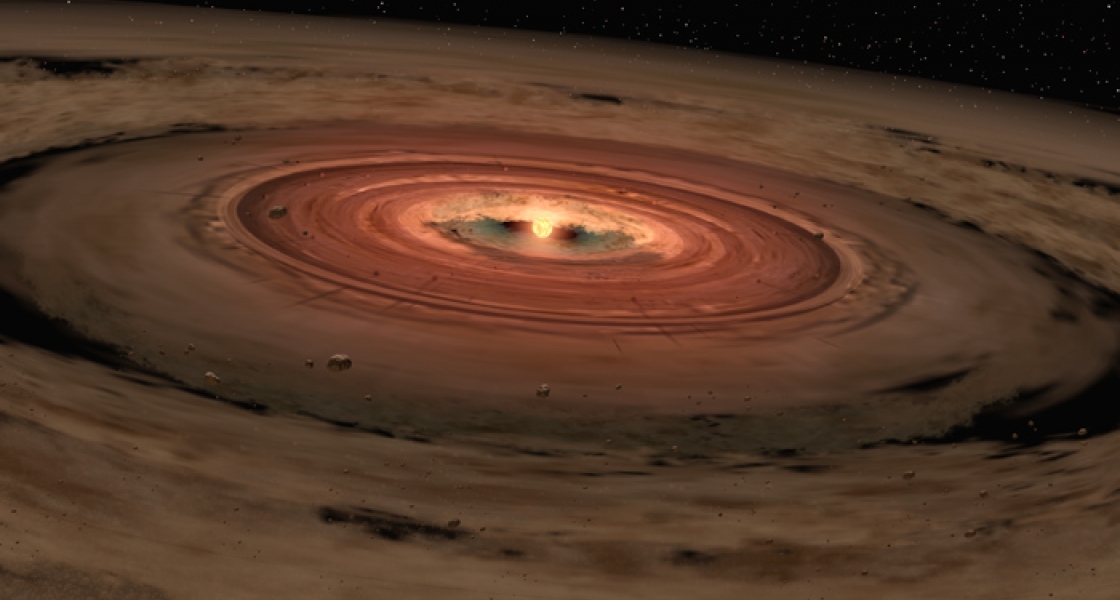Fellow Phil Armitage studies the migration of gas giant planets through evolving protoplanetary disks. He and former JILA postdoc Richard Alexander (Universiteit Leiden) have designed relatively simple models that reproduce the observed frequency and distribution of extra-solar giant planets, many of which orbit very close to their stars. The models also replicate the masses, lifetimes, and evolution of protoplanetary disks.
What’s new is that, in some cases, planet formation appears to be coupled to disk clearing. The addition of disk winds to the models results in this coupling, which has not been seen before in planet-formation models. Because of the disk wind, a giant planet migrating toward its star must continue to accrete dust and gas as it moves inward, while simultaneously allowing more gas to flow onto the star. Otherwise, it won’t be able to survive the migration process and end up on a stable orbit within ~1.5 AU (the distance between the Earth and the Sun). Since most of the giant extra-solar planets observed so far are in orbits of 1.5 AU, many planets clearly do accrete material as they move in across possible planetary orbits.
Interestingly, however, the models reveal that the accretion of material during migration does not explain the observed range of sizes for gas giant planets. Thus, the planet formation process itself is responsible for producing planets ranging in size from about a tenth the size of Jupiter to 10 times the size of Jupiter.
Regardless of their size, however, their ability to survive depends on timing. The new models indicate that the survival of gas giant planets depends on the timing of their formation with respect to the stage in the protoplanetary disk’s evolution. To survive, planets that are Jupiter-sized or larger must form in the latter stages of disk evolution after the disk has begun to thin. Only about 10% of the modeled disks did form a giant planet toward the end of their lifetimes, which ranged from 2.3 to 10.7 million years in the models.
The models also showed that before protoplanetary disks disappeared, they formed two kinds of "transitional" disks. NASA’s Spitzer space telescope has detected many transitional disks, but astronomers do not know whether these are reliable signposts of massive planet formation. The models suggest that younger transition disks are more likely to have embedded planets, and the older disks are more likely to be in the process of being scoured away by powerful disk outflows. - Julie Phillips



 The Physics Frontiers Centers (PFC) program supports university-based centers and institutes where the collective efforts of a larger group of individuals can enable transformational advances in the most promising research areas. The program is designed to foster major breakthroughs at the intellectual frontiers of physics by providing needed resources such as combinations of talents, skills, disciplines, and/or specialized infrastructure, not usually available to individual investigators or small groups, in an environment in which the collective efforts of the larger group can be shown to be seminal to promoting significant progress in the science and the education of students. PFCs also include creative, substantive activities aimed at enhancing education, broadening participation of traditionally underrepresented groups, and outreach to the scientific community and general public.
The Physics Frontiers Centers (PFC) program supports university-based centers and institutes where the collective efforts of a larger group of individuals can enable transformational advances in the most promising research areas. The program is designed to foster major breakthroughs at the intellectual frontiers of physics by providing needed resources such as combinations of talents, skills, disciplines, and/or specialized infrastructure, not usually available to individual investigators or small groups, in an environment in which the collective efforts of the larger group can be shown to be seminal to promoting significant progress in the science and the education of students. PFCs also include creative, substantive activities aimed at enhancing education, broadening participation of traditionally underrepresented groups, and outreach to the scientific community and general public.